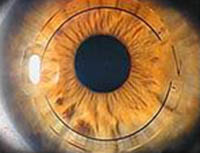 |
| How Do Intacs Work? |
 |
For treating nearsightedness, Intacs correct vision by flattening the cornea to refocus light rays and improve vision. For keratoconus, Intacs work
by flattening the steep part of the cornea or cone to reduce vision distortions. |
| Intacs are made of the same biocompatible material found in cataract lens implants (intraocular lenses), so there is not much risk of adverse effects from the material. |
|
 |
|
 |
| In a very few cases, however, eye irritation (blepharitis) or abnormal blood vessel growth (neovascularization) may occur. Also, Intacs may produce no corrective effect in fewer than 5 percent of individuals with keratoconus. |
 |
| The procedure takes about 15 minutes and is done on an outpatient basis: you walk in and walk out later, but will need someone to drive you home after surgery. Before surgery, your doctor places anesthetizing drops in your eye and may give you a mild oral sedative. |
 |
| During the procedure, your surgeon creates a tunnel between layers of the corneal stroma, outside of the central optical zone. The surgeon then chooses the appropriate ring thickness. A thicker ring in Intacs means more flattening of the cornea, which increases the level of vision correction achieved. After one or two crescent-shaped Intacs are inserted into the tunnel, the procedure is over. |
 |
| After Intacs Surgery |
 |
You'll probably rest for a while, then go home (have someone else drive you). Most people have sharper vision the first day after surgery, but you may need a couple of days of relaxation to promote healing.
You won't feel the ring segments, because they are beneath the cornea's nerve endings. Other people can't see them unless they look very closely into your eyes. |
 |
| Intacs for myopia or keratoconus work by flattening corneal curvature. Photo provided by the manufacturer. |
 |
| Results of these implants will depend on the degree of keratoconus in each individual. People with milder cases of keratoconus may not need any lenses for additional vision correction. People with moderate keratoconus may require glasses or soft contact lenses for improved vision. For more advanced cases, rigid gas permeable contact lenses may be needed to improve vision or to delay or prevent the need for a corneal transplant. |
 |
| Intacs can be very effective at changing the cornea and flattening the cone caused by keratoconus. But if you have advanced keratoconus, Intacs cannot halt the progression caused by weakening of surface eye tissue (collagen) responsible for corneal strength. |
 |
| Research is continuing into an investigational procedure called corneal cross-linking, which fortifies eye tissue to keep it from degrading. |
 |
| Are You a Candidate for Intacs? |
 |
| Many young adults experience changes in their glasses and contact lens prescriptions, even up to |
|
|
|
| their early 30s. These are normal physiological changes, but people in this age group would not be good candidates for the procedure until their eyes have "settled down" into one prescription. |
 |
| You may be eligible for corneal ring implantation if you: |
- Are an adult over 21.
- Have keratoconus.
- Have stable vision.
- Have mild myopia with 1 diopter or less of astigmatism, although Intacs no longer are being marketed heavily for this type of vision correction.
|
 |
| After examining your eyes, we will tell you more about Intacs. As for cost, it varies from surgeon to surgeon, but is generally slightly more than for laser vision correction. |
